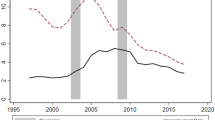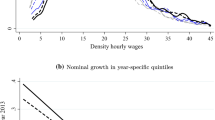Summary
December 1, 1996 a new law was implemented in Portugal to gradually reduce the standard workweek from 44 to 40 h. We study how this mandatory reduction affected employment through job creation and job destruction. There was considerable regional, sectoral and firm-size variation in the share of workers who were affected by the working hours reduction. We exploit this variation to assess the impact of the workweek reduction. We find evidence that the working hours reduction had a positive effect on employment through a fall in job destruction.
Article PDF
Similar content being viewed by others
Avoid common mistakes on your manuscript.
References
Andrews M.J., Schank T., Simmons R. (2005) ‘Does Worksharing Work? Some Empirical Evidence from the IAB-Establishment Panel’. Scottish Journal of Political Economy 52: 141–176
Bertrand M., Duflo E., Mullainathan S. (2004) ‘How much Should We Trust Differences-in-Differences Estimates?’. Quarterly Journal of Economics 119: 249–275
Blanchard O., Portugal P. (2001) ‘What Hides Behind an Unemployment Rate: Comparing Portuguese and U.S. labor markets’. American Economic Review 91: 187–207
Boeri, T. and J.C. Van Ours (2008), The Economics of Imperfect Labor Markets, Princeton University Press.
Calmfors L., Hoel M. (1988) ‘Worksharing and Overtime’. Scandinavian Journal of Economics 90: 45–62
Cardoso A.R. (2006) ‘Wage Mobility: Do Institutions Make a Difference? A Replication Study Comparing Portugal and the UK’. Labour Economics 13: 387–404
Chemin M., Wasmer E. (2009) ‘Using Alsace-Moselle Local Laws to Build a Difference- in-Differences Estimation Strategy of the Employment Effects of the 35-Hour Workweek Regulation in France. Journal of Labor Economics 27: 487–524
Crépon B., Kramarz F. (2002) ‘Employed 40 Hours or Not-Employed 39: Lessons from the 1982 Workweek Reduction in France’. Journal of Political Economy 110: 1355–1389
Davis S.J., Haltiwanger J. (1999) ‘Gross Job Flows’. In: Ashenfelter O., Card D. (eds) Handbook of Labor Economics, vol. 3. Elsevier, Amsterdam, pp 2711–2805
Estevão M., Sá F. (2008) ‘The 35 Hour Workweek in France: Straightjacket or Welfare Improvement?’. Economic Policy 55: 417–463
Hunt J. (1999) ‘Has Work-Sharing Worked in Germany?’. Quarterly Journal of Economics 114: 117–148
Manning, A. (2003), Monopsony in Motion: Imperfect Competition in Labor Markets, Princeton University Press.
Mata J., Portugal P. (1994) ‘Life Duration of New Firms’. Journal of Industrial Economics 42: 227–245
Marimon R., Zillibotti F. (2000) ‘Employment and Distributional Effects of Restricting Working Time’. European Economic Review 44: 1291–1326
Raposo P., Van Ours J.C. (2010) ‘How Working Time Reduction Affects Jobs and Wages’. Economics Letters 106: 61–63
Sánchez, R. (2009), Do Reductions of Standard Hours Affect Employment Transitions? Evidence from Chile, mimeo, University of Warwick.
Skuterud M. (2007) ‘Identifying the Potential of Work-Sharing as a Job-Creation Strategy’. Journal of Labor Economics 25: 265–287
Stewart M. (2002) ‘Estimating the impact of the minimum wage using geographical wage variation’. Oxford Bulletin of Economics and Statistics 64: 583–605
Varejão, J. (2005), Work-Sharing Revisited—Lessons from a Natural Experiment, mimeo, Faculdade de Economia do Porto, Porto.
Open Access
This article is distributed under the terms of the Creative Commons Attribution Noncommercial License which permits any noncommercial use, distribution, and reproduction in any medium, provided the original author(s) and source are credited.
Author information
Authors and Affiliations
Corresponding author
Additional information
We are grateful to the Ministry of Employment, Statistics Department, for access to the QP data. We thank two anonymous referees for helpful comments on a previous version of the paper. Pedro S. Raposo gratefully acknowledges financial support by the Portuguese Foundation of Science and Technology, FCT [SFRH/BD/21906/2005].
Rights and permissions
Open Access This is an open access article distributed under the terms of the Creative Commons Attribution Noncommercial License (https://creativecommons.org/licenses/by-nc/2.0), which permits any noncommercial use, distribution, and reproduction in any medium, provided the original author(s) and source are credited.
About this article
Cite this article
Raposo, P.S., Van Ours, J.C. How a Reduction of Standard Working Hours Affects Employment Dynamics. De Economist 158, 193–207 (2010). https://doi.org/10.1007/s10645-010-9142-5
Published:
Issue Date:
DOI: https://doi.org/10.1007/s10645-010-9142-5




